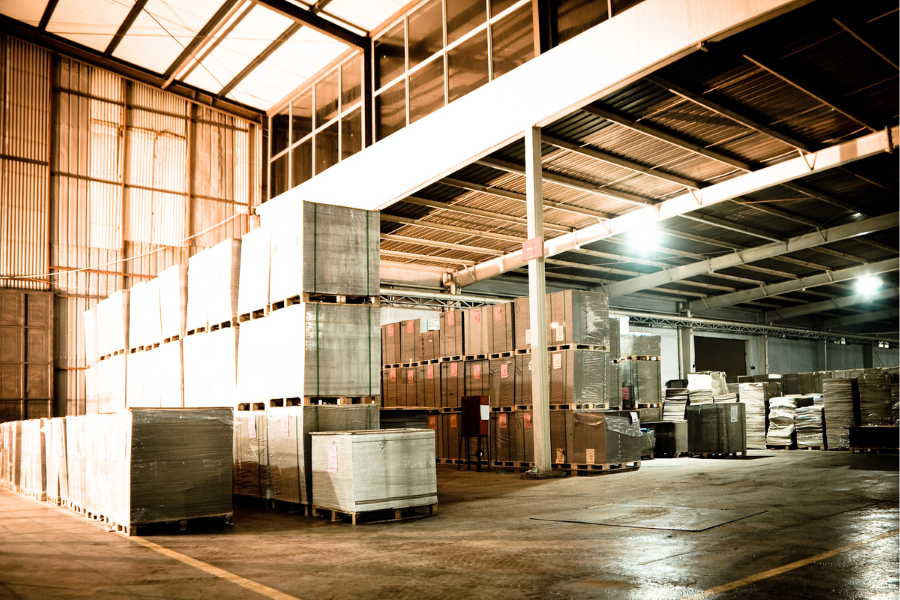Warehouses and distribution centers are complex operations and “efficiency” has different meanings depending on business needs. Ideas to improve workplace efficiency come in many shapes and sizes. Whether you’re hoping to revamp your warehouse layout, workforce, business practices or all three and maybe more, improving efficiency should result in reduced costs and increased productivity.
The terms “warehouse” and “distribution center” are often used interchangeably, which is not quite correct. A warehouse is any building used to store inventory, while a distribution center is a specific type of warehouse designed to receive, store and distribute products to customers. Fortunately, the methods to improve efficiency at one typically apply to the other.
There are four general levels of warehouse or distribution center activity:
- Low activity with low storage requirements.
- High activity with low storage requirements.
- Low activity with high storage requirements.
- High activity with high storage requirements.
Every industry has different needs and levels of activity, and that activity level may fluctuate throughout the year). Even within the same industry, needs and activity levels often differ from organization to organization. That’s why there’s no single “correct” way to improve efficiency at a warehouse or distribution center. Warehouse owners and managers must find a solution for their unique needs.
How to improve efficiency at work through a warehouse layout
Finding the best warehouse layout for your business’s needs can drastically reduce the travel time through the building, which should improve efficiency and workflow. In general, there are three main warehouse layouts:
- The U-shaped design has receiving docks at one end of the U and the dispatch area at the other end. Inventory is stored in the middle. The streamlined flow of a U-shaped design works for most warehouses.
- An I-shaped design places receiving and dispatch areas on opposite ends of a building. This layout is also known as a “through-flow warehouse” because it’s a straight shot through receiving, reception, storage and dispatch.
- For an L-shaped design, receiving and dispatch are separated by a 90-degree angle. The L-shaped design is also considered a “through-flow” warehouse.
Reworking a warehouse layout to improve work efficiency should minimize travel times to reduce bottlenecks and streamline operations. Investing in the right material handling equipment, such as reach trucks and forklifts (and their all-important batteries) will ensure that inventory flows expediently through the facility.
Before settling on any warehouse design (or redesign) test the layout. Some companies use computer mockups to simulate how inventory and employees will flow through the building. However, if the bleeps and bloops of a computer simulation are unavailable to you, there is an analog method that may work even better. Use masking tape to create silhouettes of the entire warehouse layout. Then work with your team to run drills carrying boxes, controlling pallet jacks and even driving forklifts through the area.
Also, always remember that your needs are likely to change throughout the years. To continually improve efficiency at work, create a warehouse layout with built-in flexibility to accommodate changes like expanded product lines or differently sized inventory.
How to improve efficiency in a business workforce
Improved communication with your warehouse workforce is a powerful way to improve business efficiency and employee performance. One of the most efficient communication methods is to set expectations by establishing performance metrics on operations ranging from order fulfillment rate, picking accuracy,
inventory accuracy and turnover, fulfillment accuracy rate, receiving efficiency and more. Also, ask for, listen to and respond to feedback on these metrics. If most employees feel they are unreasonable, they likely are, and you may need to reevaluate them.
Another communication solution is to schedule regular team meetings. Now, we’ve all been to business meetings that felt like they robbed hours from our lives. We’re not advocating for those kinds of meetings. Instead, have some items ready to discuss and ask your team leaders and managers to be ready with some thoughts. However, you should mainly allow your staff to lead the discussion. You’ll likely learn more by listening.
Finally, establish robust training procedures. The best way to ensure a motivated and efficient workforce is to make sure they are comfortable and prepared on their first full day on the job. However, this training approach isn’t just for new hires. You can also apply these techniques to employee upskilling to ensure your workforce is comfortable with the latest techniques while adhering to all safety standards. It is also recommended to cross-train employees to perform multiple tasks as a buffer for vacations and sick days.
How to improve work efficiency through business practices
With any system as complex as a warehouse, there are bound to be some inefficiencies in the workflow. The following practices can help optimize processes and eliminate waste, significantly improving efficiency.
The 5S methodology
Originally developed in Japan, 5S is a way to create a clean, uncluttered, safe and organized workplace that reduces waste and optimizes productivity. The 5 S-related steps are:
- Sort—place all items in exclusive, designated locations.
- Set in order—organize them by where they are most needed.
- Shine—clean the workplace and keep it clean.
- Standardize—learn lessons from the previous three steps to create easy-to-follow processes.
- Sustain—continue following and refining these processes.
ABC analysis
An ABC analysis evaluates inventory based on importance. Goods are placed into either A, B or C categories, with A being the most important and C being the least. An ABC analysis helps warehouse managers ensure they always have enough “A” stock to satisfy demand. Should demand decrease or increase for an item, managers can easily spot the change and reclassify it as needed.
Just-in-time inventory
Just-in-time (JIT) inventory reduces the inventory held at a warehouse by aligning orders with demand. This approach is designed to reduce costs by keeping inventory levels low and receiving goods only when needed to meet customer demand. Correctly implementing a JIT approach requires a commitment to quality control, flexibility and adaptability.
Warehouse management systems
Warehouse management systems are comprehensive software solutions that manage all warehouse operations, from inventory tracking to order fulfillment. You likely have a system in place, but is it the right one for your operation? If you feel that your operations are not as streamlined as they could be, you may need to reevaluate your current warehouse management system.
How to improve efficiency in a warehouse or distribution center? The solution may involve optimizing layouts, employee training, implementing lean practices and new approaches to inventory management or all the above. At Texas Motive Solutions, we can help make your new efficiencies even more efficient by ensuring that your material handling equipment operates at its best with our complimentary forklift fleet performance analysis. We provide top-of-the-line forklift batteries and accessories for all your forklift repair and battery needs. Please call us at (888) 316-2459 or fill out this form to learn about our services and discover everything that we can do for you.



